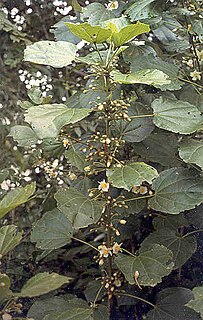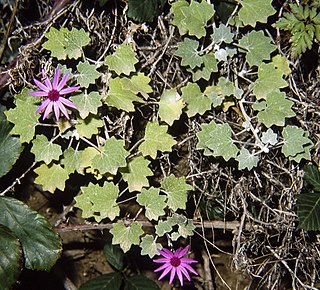
Senecioneae is the largest tribe of the Asteraceae, or the sunflower family, comprising about 150 genera and 3,000 species. Almost one-third of the species in this tribe are placed in the genus Senecio. Its members exhibit probably the widest possible range of form to be found in the entire plant kingdom, and include annuals, minute creeping alpines, perennial herbs, shrubs, climbers, succulents, trees, and semiaquatic plants.

Pericallis × hybrida, known as cineraria, florist's cineraria or common ragwort is a flowering plant in the family Asteraceae. It originated as a hybrid between Pericallis cruenta and P. lanata, both natives of the Canary Islands. The hybrid was first developed in the British royal gardens in 1777. It was originally known as Cineraria × hybrida, but the genus Cineraria is now restricted to a group of South African species, with the Canary Island species being transferred to the genus Pericallis; some botanists also treat it in a broad view of the large and widespread genus Senecio. Some varieties are sold under the trade name Senetti.

Cineraria is a genus of flowering plants in the sunflower family, native primarily to southern Africa with a few species farther north. The genus includes herbaceous plants and small subshrubs.

Pericallis is a small genus of 14 species of flowering plants in the family Asteraceae, native to the Canary Islands, Madeira and Azores. The genus includes herbaceous plants and small subshrubs. In the past, the genus was often included in either Cineraria or Senecio.

Leucocoryne(glory-of-the-sun) is a genus of bulbous perennials in the family Amaryllidaceae. The foliage of all species is long and narrow and has an onion-like scent. The blue, white or lilac flowers are held in umbels.

Hampea is a genus of flowering plants in the family Malvaceae. They are trees native to Mexico, Central America, and Colombia. There are about 21 species.
Vriesea appendiculata is a species of plant in the family Bromeliaceae. It is endemic to Ecuador. Its natural habitats are subtropical or tropical moist montane forests and subtropical or tropical high-altitude shrubland. It is threatened by habitat loss.

Brodiaea appendiculata, the appendage brodiaea or appendage cluster-lily,) is an uncommon species of plant in the genus Brodiaea.
Utricularia appendiculata is a medium-sized, probably perennial, terrestrial carnivorous plant that belongs to the genus Utricularia and is the only member of Utricularia sect. Oliveria. U. appendiculata is endemic to Africa, where it can be found in Burundi, Cameroon, the Central African Republic, the Democratic Republic of the Congo, Gabon, Madagascar, Malawi, Mozambique, Tanzania, Uganda, and Zimbabwe. It grows as a terrestrial plant in wet Sphagnum bogs, damp sandy savannas, or in peaty marshes at altitudes from 1,500 m (4,921 ft) to 1,860 m (6,102 ft), but as low as 700 m (2,297 ft) in the Central African Republic. It flowers mostly in the wet season. It was originally published and described by Eileen Adelaide Bruce in 1933 and was placed in its own section, Oliveria, in 1986 by Peter Taylor.

Oraniopsis is a monotypic genus of flowering plant in the palm family from Queensland, Australia, where the only known species, Oraniopsis appendiculata, grows in mountainous rain forest. Dioecious and extremely slow growing, the name means "similar to Orania" and the Latin epithet translates to "appendaged".
Nepenthes appendiculata is a tropical pitcher plant known only from the Hose Mountains of central Sarawak, Borneo, where it grows at elevations of 1450–1700 m above sea level. The species is characterised by an enlarged glandular appendage on the lower lid surface, for which it is named.

New Nepenthes: Volume One is a reference work by Stewart McPherson on the pitcher plants of the genus Nepenthes. It was published in 2011 by Redfern Natural History Productions and focuses on discoveries made since the release of McPherson's 2009 monograph, Pitcher Plants of the Old World. The book was edited by Alastair Robinson.

Cretalamna is a genus of extinct otodontid shark that lived from the Late Cretaceous to Eocene epoch. It is considered by many to be the ancestor of the largest sharks to have ever lived, Carcharocles angustidens, and Carcharocles megalodon.

Pericallis lanata is a species of flowering plant in the family Asteraceae. It is endemic to the Canary Islands.

Pericallis echinata is a species of flowering plant in the family Asteraceae. It is native to Tenerife in the Canary Islands.

Pericallis tussilaginis is a species of flowering plant in the family Asteraceae.

Xylocopa appendiculata is a species of carpenter bee in the family Apidae.

Lobelia appendiculata is a species of flowering plant in the bellflower family known by the common name pale lobelia. It is found in the south-central portion of North America.
Acianthera appendiculata is a species of orchid plant native to the Dominican Republic.















